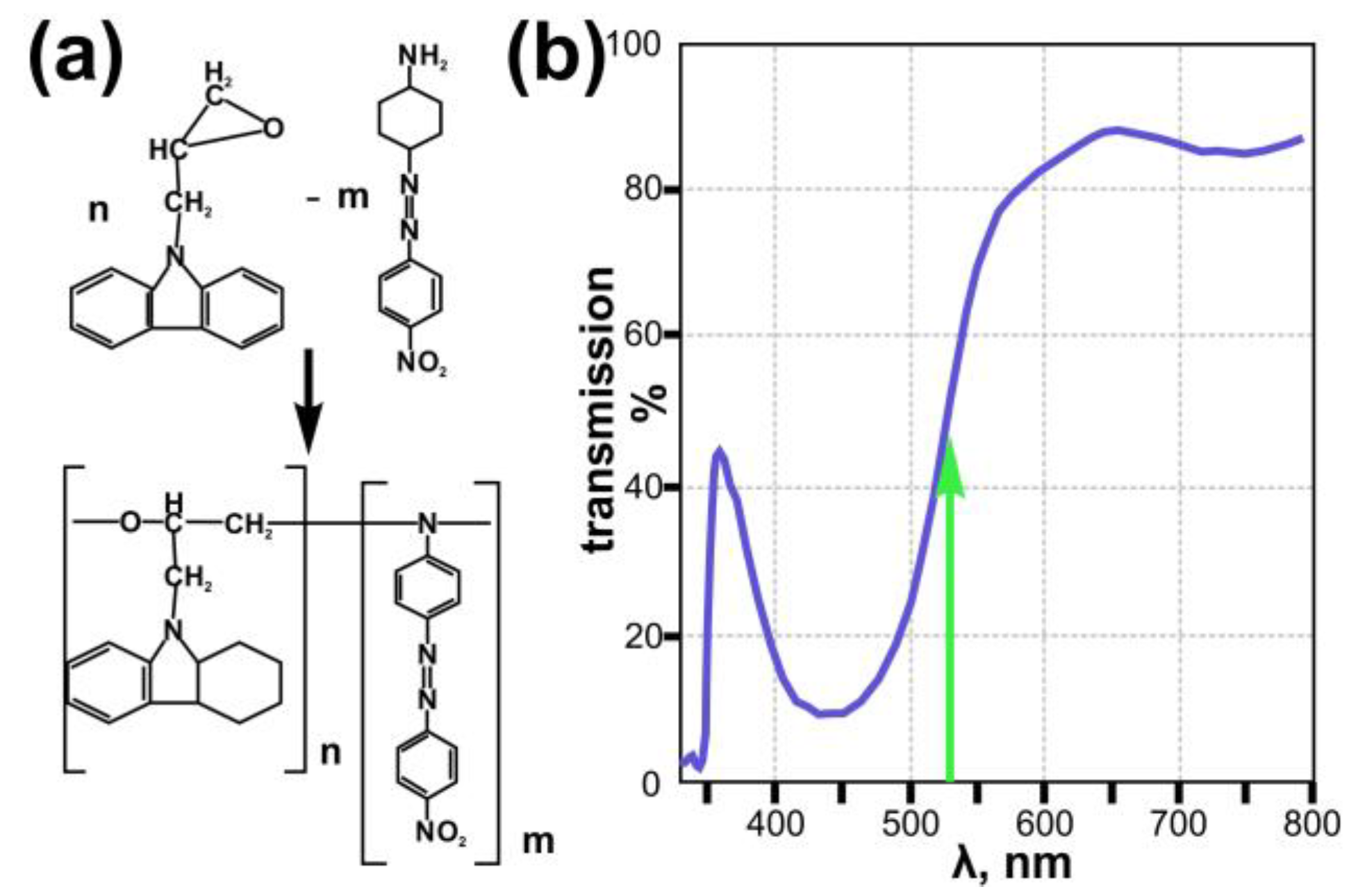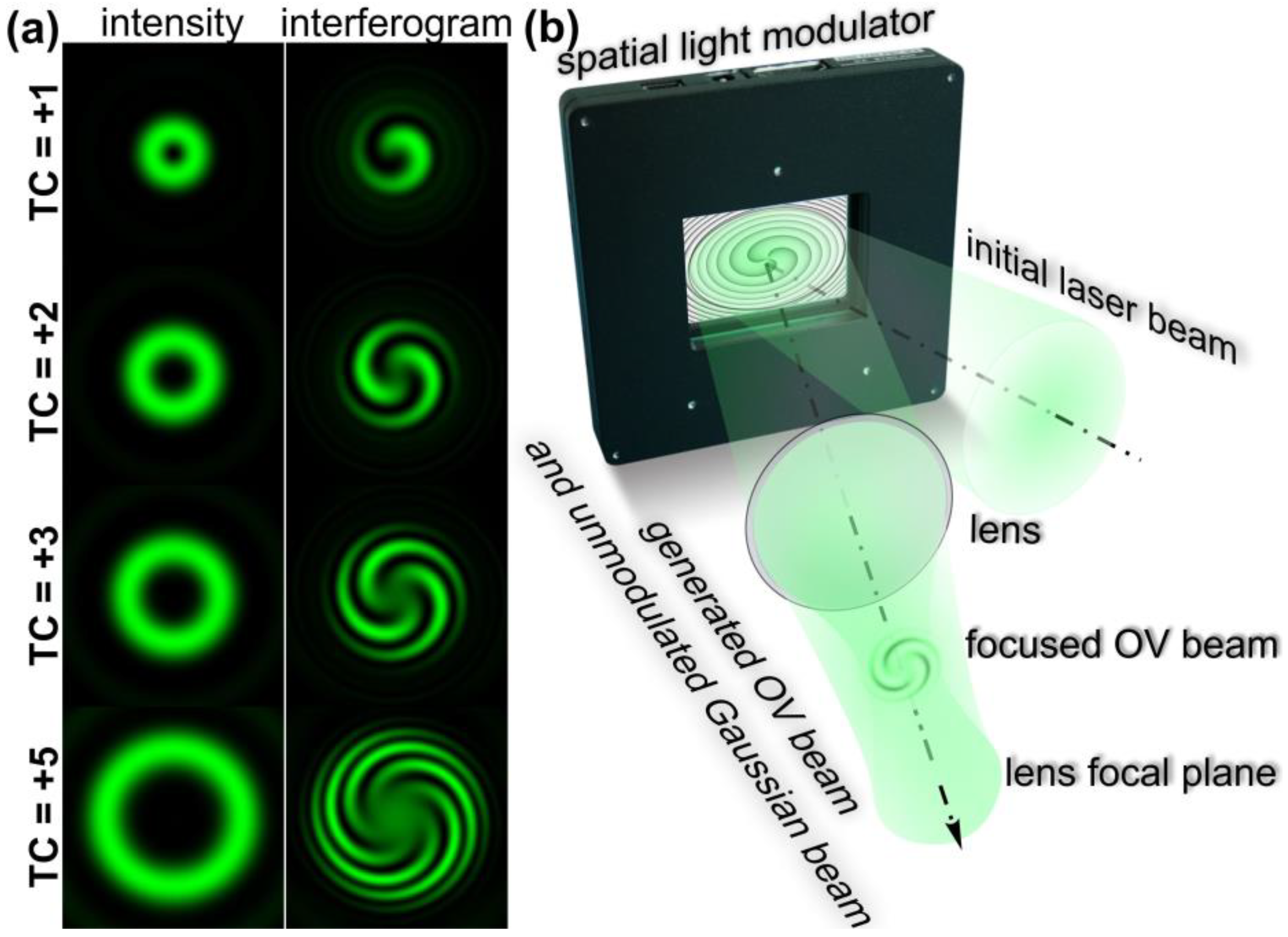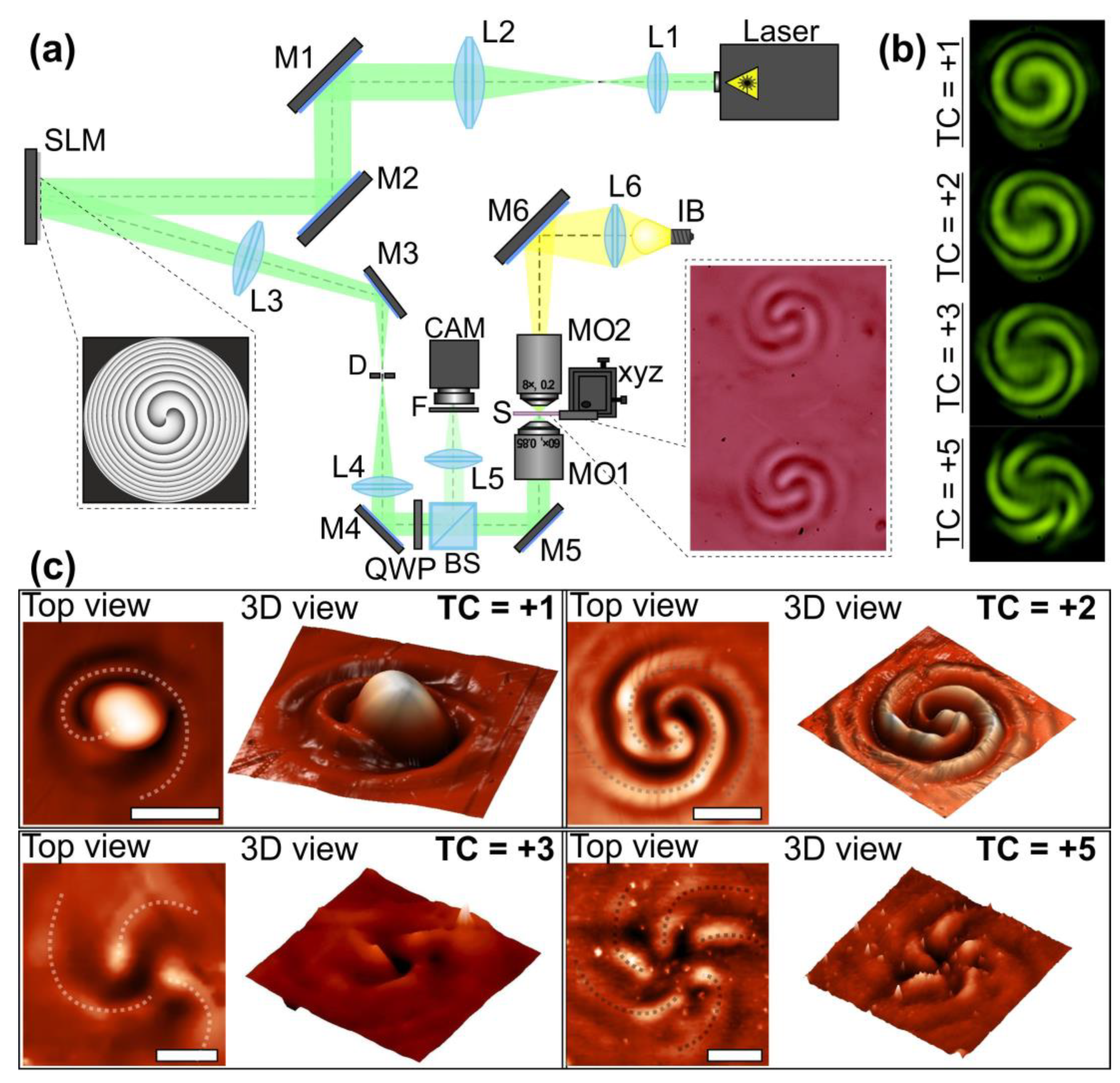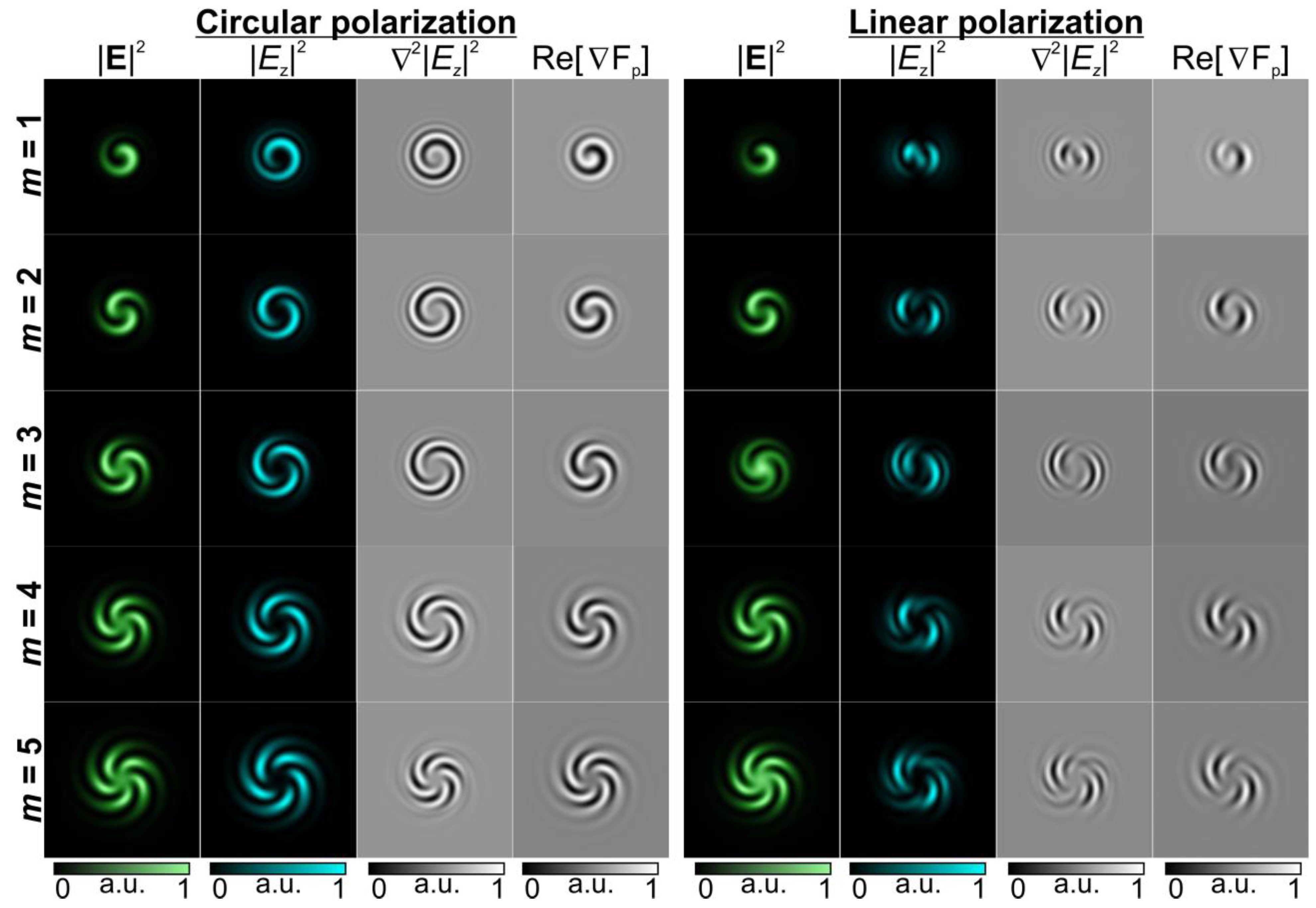Multi-Spiral Laser Patterning of Azopolymer Thin Films for Generation of Orbital Angular Momentum Light
Abstract
:1. Introduction
2. Materials and Methods
2.1. Azopolymer Thin Film Preparation
2.2. Spiral-Shaped Intensity Pattern Generation
3. Experimental Results
3.1. Realization of Multi-Spiral Laser Patterning of Azopolymer Thin Films
3.2. Generation of OAM Light Using the Fabricated Spiral-Shaped Microstructures
4. Discussion
5. Conclusions
Author Contributions
Funding
Data Availability Statement
Conflicts of Interest
References
- Porfirev, A.P.; Kuchmizhak, A.A.; Gurbatov, S.O.; Juodkazis, S.; Khonina, S.N.; Kul’chin, Y.N. Phase Singularities and Optical Vortices in Photonics. Phys. Usp. 2022, 65, 789–811. [Google Scholar] [CrossRef]
- Yao, A.M.; Padgett, M.J. Orbital Angular Momentum: Origins, Behavior and Applications. Adv. Opt. Photon. 2011, 3, 161. [Google Scholar] [CrossRef]
- Ni, J.; Liu, S.; Hu, G.; Hu, Y.; Lao, Z.; Li, J.; Zhang, Q.; Wu, D.; Dong, S.; Chu, J.; et al. Giant Helical Dichroism of Single Chiral Nanostructures with Photonic Orbital Angular Momentum. ACS Nano 2021, 15, 2893–2900. [Google Scholar] [CrossRef] [PubMed]
- Hahn, M.S.; Miller, J.S.; West, J.L. Laser Scanning Lithography for Surface Micropatterning on Hydrogels. Adv. Mater. 2005, 17, 2939–2942. [Google Scholar] [CrossRef]
- Li, Y.; Qu, S.L. Fabrication of Spiral-Shaped Microfluidic Channels in Glass by Femtosecond Laser. Mater. Lett. 2010, 64, 1427–1429. [Google Scholar] [CrossRef]
- Seet, K.K.; Mizeikis, V.; Matsuo, S.; Juodkazis, S.; Misawa, H. Three-Dimensional Spiral-Architecture Photonic Crystals Obtained by Direct Laser Writing. Adv. Mater. 2005, 17, 541–545. [Google Scholar] [CrossRef]
- Tsutsumi, N.; Takai, Y.; Kinashi, K.; Sakai, W. Fabrication of Silver Helix Microstructures in a Large Area by a Two-Photon Absorption DLW Method. Sci. Rep. 2021, 11, 15860. [Google Scholar] [CrossRef] [PubMed]
- Peyer, K.E.; Qiu, F.; Zhang, L.; Nelson, B.J. Movement of Artificial Bacterial Flagella in Heterogeneous Viscous Environments at the Microscale. In Proceedings of the 2012 IEEE/RSJ International Conference on Intelligent Robots and Systems, Vilamoura-Algarve, Portugal, 7–12 October 2012; pp. 2553–2558. [Google Scholar]
- Guo, Y.; Shahsavan, H.; Sitti, M. 3D Microstructures of Liquid Crystal Networks with Programmed Voxelated Director Fields. Adv. Mater. 2020, 32, 2002753. [Google Scholar] [CrossRef] [PubMed]
- Price, R.R.; Dressick, W.J.; Singh, A. Fabrication of Nanoscale Metallic Spirals using Phospholipid Microtubule Organizational Templates. J. Am. Chem. Soc. 2003, 125, 11259–11263. [Google Scholar] [CrossRef] [PubMed]
- Pang, Y.K.; Lee, J.C.W.; Lee, H.F.; Tam, W.Y.; Chan, C.T.; Sheng, P. Chiral Microstructures (Spirals) Fabrication by Holographic Lithography. Opt. Express 2005, 13, 7615–7620. [Google Scholar] [CrossRef] [PubMed] [Green Version]
- Guo, S.Z.; Gosselin, F.; Guerin, N.; Lanouette, A.M.; Heuzey, M.C.; Therriault, D. Solvent-Cast Three-Dimensional Printing of Multifunctional Microsystems. Small 2013, 9, 4118–4122. [Google Scholar] [CrossRef]
- Ni, J.; Wang, C.; Zhang, C.; Hu, Y.; Yang, L.; Lao, Z.; Xu, B.; Li, J.; Wu, D.; Chu, J. Three-Dimensional Chiral Microstructures Fabricated by Structured Optical Vortices in Isotropic Material. Light Sci. Appl. 2017, 6, e17011. [Google Scholar] [CrossRef]
- Wen, J.; Sun, Q.; Luo, M.; Ma, C.; Yang, Z.; Su, C.; Cao, C.; Zhu, D.; Ding, C.; Xu, L.; et al. Fabrication of Chiral 3D Microstructure Using Tightly Focused Multiramp Helico-Conical Optical Beams. Micromachines 2022, 13, 1771. [Google Scholar] [CrossRef]
- Toyoda, K.; Takahashi, F.; Takizawa, S.; Tokizane, Y.; Miyamoto, K.; Morita, R.; Omatsu, T. Transfer of Light Helicity to Nanostructures. Phys. Rev. Lett. 2013, 110, 143603. [Google Scholar] [CrossRef]
- Syubaev, S.; Zhizhchenko, A.; Kuchmizhak, A.; Porfirev, A.; Pustovalov, E.; Vitrik, O.; Kulchin, Y.; Khonina, S.; Kudryashov, S. Direct Laser Printing of Chiral PlasmonicNanojets by Vortex Beams. Opt. Express 2017, 25, 10214–10223. [Google Scholar] [CrossRef]
- Rahimian, M.G.; Bouchard, F.; Al-Khazraji, H.; Karimi, E.; Corkum, P.B.; Bhardwaj, V.R. Polarization Dependent Nanostructuring of Silicon with Femtosecond Vortex Pulse. APL Photonics 2017, 2, 086104. [Google Scholar] [CrossRef]
- Takahashi, F.; Miyamoto, K.; Hidai, H.; Yamane, K.; Morita, R.; Omatsu, T. Picosecond Optical Vortex Pulse Illumination Forms a Monocrystalline Silicon Needle. Sci. Rep. 2016, 6, 21738. [Google Scholar] [CrossRef]
- Ambrosio, A.; Marrucci, L.; Borbone, F.; Roviello, A.; Maddalena, P. Light-Induced Spiral Mass Transport in Azo-Polymer Films under Vortex-Beam Illumination. Nat. Commun. 2013, 3, 989. [Google Scholar] [CrossRef] [PubMed]
- Ambrosio, A.; Maddalena, P.; Marrucci, L. Molecular Model for Light-Driven Spiral Mass Transport in Azopolymer Films. Phys. Rev. Lett. 2013, 110, 989. [Google Scholar] [CrossRef] [PubMed]
- Watabe, M.; Juman, G.; Miyamoto, K.; Omatsu, T. Light Induced Conch-Shaped Relief in an Azo-Polymer Film. Sci. Rep. 2014, 4, 4281. [Google Scholar] [CrossRef] [Green Version]
- Masuda, K.; Shinozaki, R.; Kinezuka, Y.; Lee, J.; Ohno, S.; Hashiyada, S.; Okamoto, H.; Sakai, D.; Harada, K.; Miyamoto, K.; et al. Nanoscale Chiral Surface Relief of Azo-Polymers with Nearfield OAM Light. Opt. Express 2018, 26, 22197–22207. [Google Scholar] [CrossRef]
- Porfirev, A.P.; Khonina, S.N.; Khorin, P.A.; Ivliev, N.A. Polarization-Sensitive Direct Laser Patterning of Azopolymer Thin Films with Vortex Beams. Opt. Lett. 2022, 47, 5080–5083. [Google Scholar] [CrossRef]
- Syubaev, S.; Zhizhchenko, A.; Vitrik, O.; Porfirev, A.; Fomchenkov, S.; Khonina, S.; Kudryashov, S.; Kuchmizhak, A. Chirality of Laser-Printed Plasmonic Nanoneedles Tunable by Tailoring Spiral-Shape Pulses. Appl. Surf. Sci. 2019, 47, 526–534. [Google Scholar] [CrossRef]
- Porfirev, A.; Khonina, S.; Ivliev, N.; Meshalkin, A.; Achimova, E.; Forbes, A. Writing and Reading with the Longitudinal Component of Light Using Carbazole-Containing Azopolymer Thin Films. Sci. Rep. 2022, 12, 3477. [Google Scholar] [CrossRef]
- Yager, K.G.; Barrett, C.J. Azobenzene Polymers for Photonic Applications. Smart light-responsive materials. Smart Light-Responsive Mater. 2009, 1, 1–46. [Google Scholar]
- Zhai, Y.; Cao, L.; Liu, Y.; Tan, X. A Review of Polarization-Sensitive Materials for Polarization Holography. Materials 2020, 13, 5562. [Google Scholar] [CrossRef] [PubMed]
- Priimagi, A.; Shevchenko, A. Azopolymer-Based Micro-and Nanopatterning for Photonic Applications. J. Polym. Sci. B Polym. Phys. 2014, 52, 163–182. [Google Scholar] [CrossRef]
- De Martino, S.; Mauro, F.; Netti, P.A. Photonic Applications of Azobenzene Molecules Embedded in Amorphous Polymer. La Rivistadel Nuovo Cimento 2020, 43, 599–629. [Google Scholar] [CrossRef]
- Bokare, A.; Arif, J.; Erogbogbo, F. Strategies for Incorporating Graphene Oxides and Quantum Dots into Photoresponsive Azobenzenes for Photonics and Thermal Applications. Nanomaterials 2021, 11, 2211. [Google Scholar] [CrossRef]
- Reda, F.; Salvatore, M.; Borbone, F.; Maddalena, P.; Oscurato, S.L. Accurate Morphology-Related Diffraction Behavior of Light-Induced Surface Relief Gratings on Azopolymers. ACS Mater. Lett. 2022, 4, 953–959. [Google Scholar] [CrossRef]
- Meshalkin, A.; Losmanschii, C.; Prisacar, A.; Achimova, E.; Abashkin, V.; Pogrebnoi, S.; Macaev, F. Carbazole-Based Azo-polymers as Media for Polarization Holographic Recording. Adv. Phys. Res. 2019, 1, 86–98. [Google Scholar]
- Degtyarev, S.A.; Porfirev, A.P.; Khonina, S.N. Photonic Nanohelix Generated by a Binary Spiral Axicon. Appl. Opt. 2016, 55, B44–B48. [Google Scholar] [CrossRef]
- Xiao, M.; Yang, D.; Xiong, J. Non-Contact Measurement for Cone Angle of Axicon Lens Based on Vortex Interference. Opt. Commun. 2021, 499, 127267. [Google Scholar] [CrossRef]
- Beijersbergen, M.W.; Coerwinkel, R.P.C.; Woerdman, J.P. Helical-Wavefront Laser Beams Produced with a Spiral Phase Plate. Opt. Commun. 1994, 112, 321–327. [Google Scholar] [CrossRef]
- Furhapter, S.; Jesacher, A.; Bernet, S.; Ritsch-Marte, M. Spiral Interferometery. Opt. Lett. 2005, 15, 1953–1958. [Google Scholar] [CrossRef]
- Wang, X.; Kuchmizhak, A.A.; Brasselet, E.; Juodkazis, S. Dielectric Geometric Phase Optical Elements Fabricated by Femtosecond Direct Laser Writing in Photoresists. Appl. Phys. Lett. 2017, 110, 181101. [Google Scholar] [CrossRef]
- Miniewicz, A.; Sobolewska, A.; Piotrowski, W.; Karpinski, P.; Bartkiewicz, S.; Schab-Balcerzak, E. Thermocapillary Marangoni Flows in Azopolymers. Materials 2020, 13, 2464. [Google Scholar] [CrossRef]
- Podlipnov, V.V.; Ivliev, N.A.; Khonina, S.N.; Nesterenko, D.V.; Meshalkin, A.Y.; Achimova, E.A. Formation of Microstructures on the Surface of a Carbazole-Containing Azopolymer by the Action of Laser Beams. J. Phys. Conf. Ser. 2019, 1368, 022069. [Google Scholar] [CrossRef]
- Kumar, J.; Li, L.; Jiang, X.L.; Kim, D.Y.; Lee, T.S.; Tripathy, S. Gradient Force: The Mechanism for Surface Relief Grating Formation in Azobenzene Functionalized Polymers. Appl. Phys. Lett. 1998, 72, 2096. [Google Scholar] [CrossRef]
- Richards, B.; Wolf, E. Electromagnetic Diffraction in Optical Systems, II. Structure of the Image Field in an Aplanatic System. Proc. R. Soc. A: Math. Phys. Eng. Sci. 1959, 253, 358–379. [Google Scholar]
- Khonina, S.N.; Ustinov, A.V.; Volotovskiy, S.G.; Ivliev, N.A.; Podlipnov, V.V. Influence of Optical Forces Induced by Paraxial Vortex Gaussian Beams on the Formation of a Microrelief on Carbazole-Containing Azopolymer Films. Appl. Opt. 2020, 59, 9185–9194. [Google Scholar] [CrossRef] [PubMed]
- Khonina, S.N.; Golub, I. Optimization of Focusing of Linearly Polarized Light. Opt. Lett. 2011, 36, 352–354. [Google Scholar] [CrossRef] [PubMed]
- Porfirev, A.P.; Ustinov, A.V.; Khonina, S.N. Polarization Conversion when Focusing Cylindrically Polarized Vortex Beams. Sci. Rep. 2016, 6, 6. [Google Scholar] [CrossRef] [PubMed] [Green Version]
- Bégin, J.L.; Jain, A.; Parks, A.; Hufnagel, F.; Corkum, P.; Karimi, E.; Brabec, T.; Bhardwaj, R. Nonlinear Helical Dichroism in Chiral and Achiral Molecules. Nat. Photon. 2022, 17, 82–88. [Google Scholar] [CrossRef]





Disclaimer/Publisher’s Note: The statements, opinions and data contained in all publications are solely those of the individual author(s) and contributor(s) and not of MDPI and/or the editor(s). MDPI and/or the editor(s) disclaim responsibility for any injury to people or property resulting from any ideas, methods, instructions or products referred to in the content. |
© 2023 by the authors. Licensee MDPI, Basel, Switzerland. This article is an open access article distributed under the terms and conditions of the Creative Commons Attribution (CC BY) license (https://creativecommons.org/licenses/by/4.0/).
Share and Cite
Porfirev, A.P.; Ivliev, N.A.; Fomchenkov, S.A.; Khonina, S.N. Multi-Spiral Laser Patterning of Azopolymer Thin Films for Generation of Orbital Angular Momentum Light. Nanomaterials 2023, 13, 612. https://doi.org/10.3390/nano13030612
Porfirev AP, Ivliev NA, Fomchenkov SA, Khonina SN. Multi-Spiral Laser Patterning of Azopolymer Thin Films for Generation of Orbital Angular Momentum Light. Nanomaterials. 2023; 13(3):612. https://doi.org/10.3390/nano13030612
Chicago/Turabian StylePorfirev, Alexey P., Nikolay A. Ivliev, Sergey A. Fomchenkov, and Svetlana N. Khonina. 2023. "Multi-Spiral Laser Patterning of Azopolymer Thin Films for Generation of Orbital Angular Momentum Light" Nanomaterials 13, no. 3: 612. https://doi.org/10.3390/nano13030612




